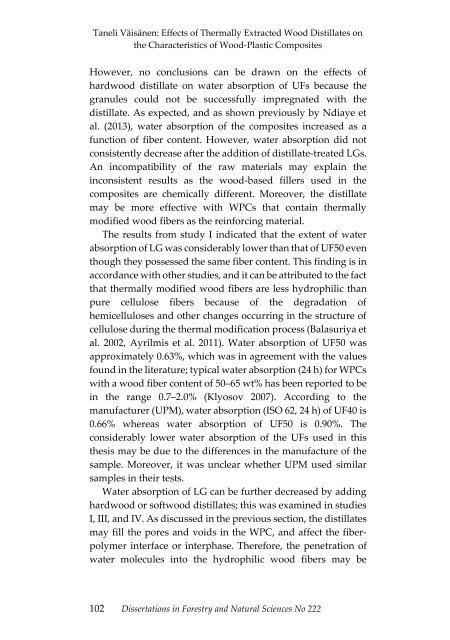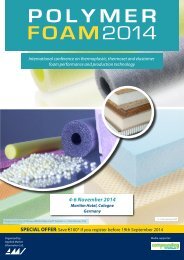Dissertations in Forestry and Natural Sciences
24lYKFN
24lYKFN
You also want an ePaper? Increase the reach of your titles
YUMPU automatically turns print PDFs into web optimized ePapers that Google loves.
Taneli Väisänen: Effects of Thermally Extracted Wood Distillates on<br />
the Characteristics of Wood-Plastic Composites<br />
However, no conclusions can be drawn on the effects of<br />
hardwood distillate on water absorption of UFs because the<br />
granules could not be successfully impregnated with the<br />
distillate. As expected, <strong>and</strong> as shown previously by Ndiaye et<br />
al. (2013), water absorption of the composites <strong>in</strong>creased as a<br />
function of fiber content. However, water absorption did not<br />
consistently decrease after the addition of distillate-treated LGs.<br />
An <strong>in</strong>compatibility of the raw materials may expla<strong>in</strong> the<br />
<strong>in</strong>consistent results as the wood-based fillers used <strong>in</strong> the<br />
composites are chemically different. Moreover, the distillate<br />
may be more effective with WPCs that conta<strong>in</strong> thermally<br />
modified wood fibers as the re<strong>in</strong>forc<strong>in</strong>g material.<br />
The results from study I <strong>in</strong>dicated that the extent of water<br />
absorption of LG was considerably lower than that of UF50 even<br />
though they possessed the same fiber content. This f<strong>in</strong>d<strong>in</strong>g is <strong>in</strong><br />
accordance with other studies, <strong>and</strong> it can be attributed to the fact<br />
that thermally modified wood fibers are less hydrophilic than<br />
pure cellulose fibers because of the degradation of<br />
hemicelluloses <strong>and</strong> other changes occurr<strong>in</strong>g <strong>in</strong> the structure of<br />
cellulose dur<strong>in</strong>g the thermal modification process (Balasuriya et<br />
al. 2002, Ayrilmis et al. 2011). Water absorption of UF50 was<br />
approximately 0.63%, which was <strong>in</strong> agreement with the values<br />
found <strong>in</strong> the literature; typical water absorption (24 h) for WPCs<br />
with a wood fiber content of 50–65 wt% has been reported to be<br />
<strong>in</strong> the range 0.7–2.0% (Klyosov 2007). Accord<strong>in</strong>g to the<br />
manufacturer (UPM), water absorption (ISO 62, 24 h) of UF40 is<br />
0.66% whereas water absorption of UF50 is 0.90%. The<br />
considerably lower water absorption of the UFs used <strong>in</strong> this<br />
thesis may be due to the differences <strong>in</strong> the manufacture of the<br />
sample. Moreover, it was unclear whether UPM used similar<br />
samples <strong>in</strong> their tests.<br />
Water absorption of LG can be further decreased by add<strong>in</strong>g<br />
hardwood or softwood distillates; this was exam<strong>in</strong>ed <strong>in</strong> studies<br />
I, III, <strong>and</strong> IV. As discussed <strong>in</strong> the previous section, the distillates<br />
may fill the pores <strong>and</strong> voids <strong>in</strong> the WPC, <strong>and</strong> affect the fiberpolymer<br />
<strong>in</strong>terface or <strong>in</strong>terphase. Therefore, the penetration of<br />
water molecules <strong>in</strong>to the hydrophilic wood fibers may be<br />
102 <strong>Dissertations</strong> <strong>in</strong> <strong>Forestry</strong> <strong>and</strong> <strong>Natural</strong> <strong>Sciences</strong> No 222



